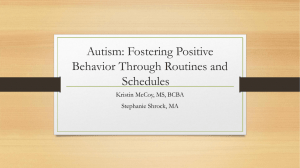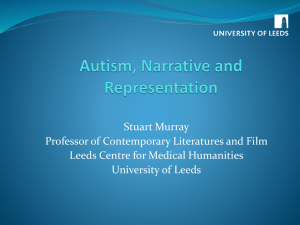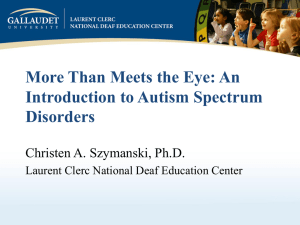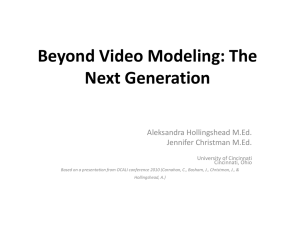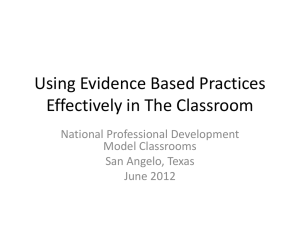Evidence Based Treatments for Autism Spectrum
advertisement
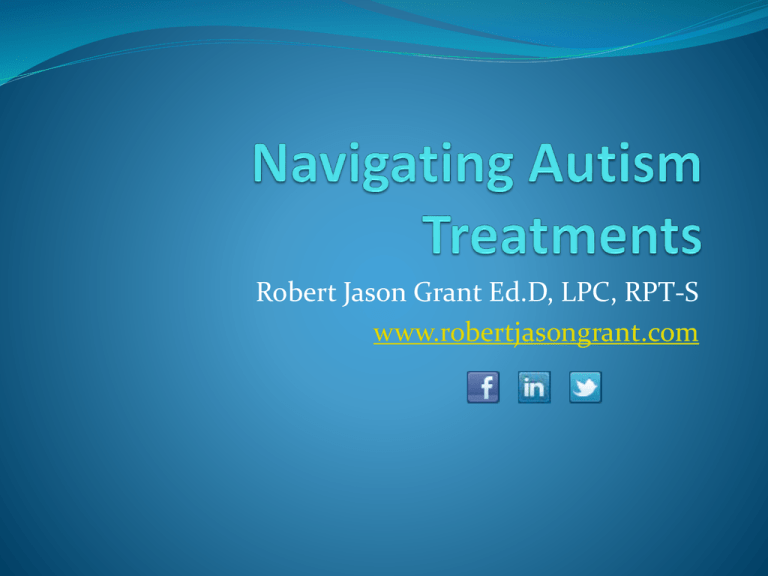
Robert Jason Grant Ed.D, LPC, RPT-S www.robertjasongrant.com Autism Spectrum Disorders Autism Aspergers Syndrome Pervasive Developmental Disorder – Not Otherwise Specified (PDD-NOS) Pervasive Developmental Disorders Autism Spectrum Disorders Rhett’s Disorder Childhood Disintegrative Disorder Pervasive Developmental Disorders Science, Pseudoscience, and Antiscience Science: strives to promote evidence based practices by using time honored methods to put hypotheses to logical and empirical tests Operational definitions Direct, reliable, and objective measurement Controlled experiments Reliance on objective data for making conclusions Independent verification of results Science, Pseudoscience, and Antiscience Pseudoscience: instead of objective measurements from well controlled experiments and independent verification from multiple research studies, pseudoscience offers testimonials and unverified personal reports to legitimatize claims Antiscience: a rejection of time tested methods of the scientific approach as a means of proving results. An extreme antiscience view would be that there are no objective facts , only personal interpretations of phenomena Treatment Warning Signs High or universal “success” rates are claimed Rapid changes are promised The treatment promotes itself as a “cure” for autism The theory behind the treatment contradicts objective knowledge The treatment is said to be easy to administer, requiring no experience The treatment excludes other treatments and emphasizes being administered exclusively Treatment Warning Signs Promoters of the treatment are working outside their area of expertise Promoters of the therapy do not have knowledge or training in working with autism spectrum disorders Little or no objective evidence is provided in support of the treatment Belief and faith are said to be necessary for the treatment to work Promoters are not open to independent evaluation of the treatment approach Selecting an Approach Three questions to consider when selecting a treatment approach: 1. What are the anticipated outcomes that align with a particular treatment, and are the outcomes in harmony with the needs of the child 2. What are the potential risks associated with the treatment 3. What are the most effective means of evaluating a particular treatment National Autism Center National Standards Project, 2009 www.nationalautismcenter.org Categories of Placement Evidence Based/Established Treatments Promising/Emerging Treatments Limited/Unestablished Treatments Not Recommended/Ineffective Treatments Evidence Based/Established Several published, peer reviewed studies Interventions and treatments in this category have undergone a substantial amount of research The evidence consistently provides results that prove children with an ASD display a significant increase in skill acquisition as a consequence of the treatment Promising/Emerging Few published, peer reviewed studies Interventions and treatments in this category have been widely used for several years without any or with few adverse outcomes The research suggests that children and youth with an ASD responded favorably from the intervention Limited Support/Unestablished May or may not be based on research, if any research base, it is very minimal May have high testimonial support but not substantiated by research Interventions and treatments in this category have not been widely utilized with children and youth with ASD’s or reflect a range of results (poor to favorable) when administered Not Recommended/Ineffective Several published peer reviewed studies Interventions and treatments in this category have been shown to not increase skill acquisition or produce favorable results Some serious detrimental effects and outcomes have been noted Autism Treatment Chart Applied Behavioral Analysis (ABA) Roots are in Behavior Theory www.bacb.com Functional Behavioral Analysis Emphasizes proactive antecedent (prevention) approaches while also providing effective strategies for intervening after a behavior has occurred Ongoing and comprehensive analysis of in individuals environment Encompasses several behavioral approaches such as prompting, fading, shaping, errorless learning, extinction, and punishment Lovaas Model Provides behavioral treatment utilizing the principles of applied behavior analysis. POSTIVE INTERACTIONS are first developed through the use of favorite activities and responding to any attempts to communicate. MOTIVATION is encouraged through the use of familiar materials and child-specific reinforces. SUCCESS is promoted through positive reinforcement of successive approximations and prompting and fading procedures. PARENTAL INVOLVEMENT is critical. Parents are empowered through training and collaboration to create an environment in which treatment is provided most of a child's waking hours, at home, at school, and in the neighborhood. REQUESTING is developed as early as possible. Learning to talk and understand vocal LANGUAGE is considered a fundamental part of social development. IMITATION is also crucial, allowing a child to learn by observing other children learn. And finally, social interactions and cooperative PLAY are integral to treatment. Facilitated play occurs first with siblings and then with peers during play dates and at school. www.lovaas.com Discrete Trial Training (DTT) Uses the principles of applied behavioral analysis (ABA) Example: the student is given a stimulus--a question, a set of blocks and a pattern, a request to go ask Mom for a glass of water--along with the correct response, or a strong 'hint' at what the response should be. He is rewarded (an M&M, a piggy-back ride, a happy "good job!") for repeating the right answer; anything else is ignored or corrected very neutrally. As his response becomes more reliable, the 'clues' are withdrawn until he can respond independently. This is usually done one-on-one at a table (thus the term table-top work), with detailed planning of the requests, timing, wording, and the therapist's reaction to the student's responses. Pivotal Response Training (PRT) Uses the principles of applied behavioral analysis (ABA) Target behaviors are taught in natural environments using items that are age appropriate and reinforcing to the child The parent or teacher presents to the child an instruction, question, or other opportunity to respond. The child responds. The parent or teacher provides some consequence to the child depending on the child’s response. Tasks should be chosen by the child as much as possible http://education.ucsb.edu/autism/ Comprehensive Behavioral Treatment for Young Children Treatment that involves a combination of ABA procedures, discrete trial, naturalistic teaching, etc. Example: Early intervention programs Learning Experiences: An Alternative Program for Preschoolers and Parents (LEAP) Uses applied behavior analysis (ABA) interventions Developed by Phil Strain phil.strain@cudenver.edu LEAP is a combination or peer-mediated instruction, incidental teaching, self-management training, prompting strategies, and systematic parent training A curriculum approach used by many special education classrooms Joint Attention Interventions Teaching a child to respond to the nonverbal social bids of others or to initiate joint attention interactions Examples: pointing to objects, showing items/activities to another person, and following eye gaze Modeling An adult or peer provides a demonstration of the target behavior that should result in an imitation of the target behavior by the individual with an ASD Can be simple or complex behaviors that are modeled Can be live modeling or video modeling Often combines with other strategies Naturalistic Teaching Strategies Incidental Teaching, Milieu Teaching, Mand Model, and Time Delay Uses strategies from the field of applied behavior analysis (ABA) Is naturalistic, in that the child leads Teacher or therapist may pre arrange environment Lessons involve interactions in which the child expresses interest and the adult responds with prompts and praise A specific lesson can be repeated several times with the adult removing the requested item and having the child initiate interest again Peer Related Interventions Teaching children without disabilities strategies for facilitating play and social interactions with children on the autism spectrum Peers can be classmates or siblings Examples include: integrated play groups, integrated social skills groups, or peer mediated groups www.autisminstitute.com These interventions may include components of other treatments Early Start Denver Model Developed by Sally Rogers and Geraldine Dawson. An "eclectic" autism intervention, combining ABA- based with non-ABA-based approaches. The manual specifies that ESDM "most closely resembles" RDI, DIR/Floortime, and SCERTS. ESDM also "has clear ties to" PRT, incidental teaching, and milieu teaching. And ESDM "has in common" some elements of ABA-based interventions as per Lovaas. Speech and occupational therapy are also thrown in. www.ucdmc.ucdavis.edu/mindinstitute/research/esd m/ Verbal Behavior Approach Guided by the principles of Applied Behavior Analysis (ABA). In addition to using ABA principles, a Verbal Behavior (VB) practitioner also incorporates BF Skinner's Analysis of Verbal Behavior. looks first at what the child wants and then teaches the child how to request. Many VB consultants also recommend the use of sign language for most non-vocal early learners. VB is child-led. www.verbalbehaviorapproach.com Schedules The presentation of a task list that communicates a series of activities or steps required to complete a specific activity Schedules can be written words, pictures or photographs, or work stations Often supplemented by other interventions Self Management Interventions Promotes independence by teaching individuals with ASD’s to regulate their behavior by recording the occurrence/non-occurrence of the target behavior, and securing reinforcement for doing so Reinforcement is usually a component of the intervention Examples include: checklists (using checks, smiling/frowning faces), counters, visual prompts, and tokens Story Based Interventions Social Stories Developed by Carol Gray www.thegraycenter.org A social story describes a situation, skill, or concept in terms of relevant social cues, perspectives, and common responses in a specifically defined style and format The four types of sentences: 1. Descriptive – tells where situations occur, who is involved, what they are doing, and why 2. Perspective – describes the reactions and feelings of the student and of other people 3. Directive – tells student what to do 4. Control – after the social story is read, the student writes sentences to help her remember the information from the social story (often considered optional) Other Resources: www.polyxo.com Play Therapy Interventions The systematic use of a theoretical model to establish an interpersonal process wherein trained play therapists use the therapeutic powers of play to help clients prevent or resolve psychosocial difficulties and achieve optimal growth and development. AutPlay Therapy www.robertjasongrant.com Filial Therapy www.play-therapy.com Theraplay www.theraplay.org Cognitive Behavioral Play Therapy Association for Play Therapy www.a4pt.org RePlays Developed by Dr. Karen Levine Pick an event that is troublesome for the child such as sitting in their car seat or going to the doctor Re-enact the event using props, if child is just beginning pretend play then the re-enactment needs to be more concrete such as where the even acutely occurs The re-enactment is done by the therapist and should be short and quick at first and grab the child’s attention. www.drkarenlevine.com Floortime(DIR)/The Play Project Developed by Stanley Greenspan A specific technique to both follow the child’s natural emotional interests (lead) and at the same time challenge the child towards greater and greater mastery of the social, emotional and intellectual capacities. Play based www.stanelygreenspan.com www.icdl.com www.playproject.org Relationship Development Intervention Developed by Dr. Steve Gutstein A parent-based intervention program where parents are provided the tools to effectively teach Dynamic Intelligence skills and motivation to their child Dynamic Intelligence skills consist of experience sharing, dynamic analysis, flexible and creative problem-solving, episodic memory and self-awareness, and resilience www.rdiconnect.com Brain Gym (Brain Based Play) Refers to the original 26 Brain Gym movements, sometimes abbreviated as the 26. These activities recall the movements naturally done during the first years of life when learning to coordinate the eyes, ears, hands, and whole body. The twenty-six activities, along with a program for “learning through movement” were developed by educator and reading specialist Paul E. Dennison and his wife and colleague, Gail E. Dennison Claim dramatic improvements in areas such as: Concentration and Focus, Memory, Academics: reading, writing, math, test taking, Physical coordination, Relationships, Self-responsibility, Organization skills, and Attitude www.braingym.com www.braingym.org Autism Movement Therapy Developed by Joanne Lara An interhemispheric SENSORY INTEGRATION technique incorporating movement and music in collaboration with Positive Behavior Support (PBS) strategies. Assists in meeting and achieving a child’s speech and language, social and academic IEP goals. www.autismmovementtherapy.com Theory of Mind Training Interventions are designed to teach individuals to recognize and identify mental states in oneself or in others and to be able to take the perspective of another person in order to predict their actions Recognizing a persons thoughts, beliefs, intentions, desires, and emotions. TEACCH Treatment and Education of Autistic and related Communication Handicapped Children. A state program originally developed in North Carolina. A complete and comprehensive program of services for autistic people which makes use of several techniques, of several methods in various combination depending upon the individual person's needs and emerging capabilities. www.teacch.com Music Therapy Teach individual skills or goals through music A targeting skill (counting, learning colors, taking turns, learning feelings) is first presented through song or rhythmic cuing Music is eventually faded Make Sound and Move Around CD www.musictherapy.org www.jamminjenn.com S.C.E.R.T.S Focuses on building competence in Social Communication, Emotional Regulation and Transactional Support. Families, educators and therapists work cooperatively as a team. Includes a well-coordinated assessment process that helps a team measure the child’s progress, and determine the necessary supports to be used by the child’s social partners (educators, peers and family members). www.scerts.com Rapid Prompting Developed by Soma Mukhopadhyay RPM uses a "Teach-Ask" paradigm for eliciting responses through intensive verbal, auditory, visual and/or tactile prompts. RPM uses prompting to initiate a student's independent response, without physical support. (RPM) improves academic success and communication. www.halo-soma.org Massage/Touch Therapies Specific massage and touch protocols Typical results include improvement in behavior, mood, sleep, and comfortableness with touch. Typical approaches include 15-minute sessions conducted twice weekly or nightly 15-minute sessions done at home by the parents before bedtime. www.amtamassage.org Picture Exchange Communication System (PECS) PECS was developed by Andrew S. Bondy & Lori Frost. A unique augmentative/alternative communication intervention package. Based on B.F. Skinner’s book, Verbal Behavior PECS begins by teaching an individual to give a picture of a desired item to a “communicative partner", who immediately honors the exchange as a request, individuals progressively moves through six phases. www.pecsusa.com Augmentative and Alternative Communication The term is applied to a variety of interventions that are utilized to compensate for expressive communication deficits. Augmentative refers to methods and devices that are used as interventions to enhance an individuals speech. Alternative refers to the use of techniques that are used to replace speech for an individual who has not or may not acquire spoken language. Assistive Technology A broad term used to describe any aid that is used to increase, maintain or improve the functional capabilities of a child with Autism. Devices an be electronic or non electronic. Adapted utensils, talking calculators, ipads, voice output devices, pencil grips, etc. Art Therapy Art therapy is a form of expressive therapy that uses the creative process of making art to improve a person’s physical, mental, and emotional well-being. It can be used for counseling by therapists to promote healing, treatment, rehabilitation, psychotherapy, and in the broad sense of the term, art therapy can be used to massage one’s inner-self in a way that may provide the individual with a deeper understanding of him or herself. www.arttherapy.org www.arttherapyblog.com www.arttherapytechniques.blogspot.com Option Method (SonRise) Developed by Barry Neil Kaufman and Samahria Lyte Kaufman. Basic components include: joining in a child's repetitive and ritualistic behaviors, utilizing a child's own motivation, teaching through interactive play, using energy, excitement and enthusiasm, employing a nonjudgmental and optimistic attitude, placing the parent as the child's most important and lasting resource, and creating a safe, distraction-free work/play area. www.autismtreatmentcenter.org Animal Assisted Therapies The Most common animal assisted therapies for Autism Disorders include: horses, dogs, cats, and dolphins. www.animalassistedtherapyprograms.com www.equine-therapy-programs.com www.dolphinassistedtherapy.com www.autismassistancedog.com www.autismservicedogsofamerica.com www.iaath.com Irlen Lenses A unique service for some children and adults identified with reading and learning difficulties, low motivation, attention deficit disorder, or discipline problems. The first testing session determines whether a person has Irlen Syndrome (a problem with the brain's ability to process visual information) and can be helped by the Irlen Method’s color technology. The second testing session targets the precise wave lengths of light causing problems by using a limitless number of color filter combinations. www.irlen.com Vision Therapy Various vision therapies and procedures designed to correct or aid in vision problems. Not specific to or created for Autism Disorders. Typically done by a medical doctor training in vision therapy and specifically in using vision therapy with Autism disorders. Thought to be helpful for children with autism who have vision problems and correction in vision problems may help with behavior issues. Aquatic Therapy Attempts to improve function through the application of aquatic therapeutic exercises. Procedures require constant attendance of a therapist educated in performing aquatic therapeutic exercises. Aquatic therapy or pool therapy is physical therapy that is performed in the water. Aquatic therapy use the resistance of water instead of weights. Helps with autism in calming the children, improving movement, range of motion, improved body awareness, increased balance, sensory integration, and mobility skills. www.aquaticpt.org www.atri.org www.angelfishtherapy.com Fast ForWord A family of educational software products intended to enhance cognitive skills of children, especially focused on developing phonological awareness. Typically used in school settings. Promotes strengthening the skills of memory, attention, processing rate, and sequencing for children. Participants spend 30 to 100 minutes a day, five days a week, for four to 16 weeks using the products. www.scilearn.com MERIT Approach Mentalization Enhanced Remediation –an Integrated Treatment. Mentalization describes the process in which we attend to the thoughts and feelings of another. Incorporates A.B.A. and other more developmentally based approaches. Provides metalizing experiences to forge a relationship with the child, allowing mentalization to inform the treatment on a regular basis, and remediating the socialemotional areas that prevent the child from progressing in this area of development. www.jeniferClark.com Transcranial Magnetic Stimulation Scientists use a device to stimulate the brain non- invasively in alert, awake patients. A simple procedure that lasts approximately 20 minutes. Regarded as being safe without any lasting side effects. May reduce symptoms associated with Autism as brain stimulation awakes and connects parts of the brain that may be associated with creating Autism symptoms. Auditory Integration Training Created by Guy Bérard. Typically involves 20 half-hour sessions over 10 days listening to specially filtered and modulated music. aims to address the sensory problems such as hearing distortions and oversensitive hearing, which are said to cause discomfort and confusion in persons suffering from learning disabilities, including autism spectrum disorders. www.aitinstitute.org Has not had favorable research. The Davis Model of Sound Intervention Created by Dorinne S. Davis Uses sound vibration with special equipment, modified music, and/or specific tones/beats, the need for which is identified with appropriate testing. Clients use headphones and sound proof rooms. Treatment is 20 one-half hour listening sessions using special listening devices. Sessions are twice a day for 10 days and must be separated by a minimum of three hours and extend over a two week period which can be separated by a weekend. www.thedaviscenter.com Chelation Treatment The administration of chelating agents to remove heavy metals from the body. Chelation therapy is used as a treatment for acute mercury, iron, arsenic, lead, uranium, plutonium and other forms of toxic metal poisoning. The chelating agent may be administered intravenously, intramuscularly, or orally, depending on the agent and the type of poisoning. It has been suggested that Chelation therapy helps reduce the symptoms of Autism. Gentle Teaching Not a behavioral modification approach. Focuses on four primary goals: Teaching the person to feel safe with us. Teaching the person to feel engaged. Teaching the person to feel unconditionally valued. Teaching the person to return unconditional valuing. Uses the relationship between the Individual and the Caregiver as the foundation for teaching. Does not focus on compliance or obedience, but focuses on teaching Individuals to feel safe with others. www.gentleteaching.sharevision.ca Van Dijk Approach A set of curriculum that can be taught to help improve communication, socialization, and sensory deficits. The method involves several joint encounters where both individuals (child and adult) experience events together in an effort for the adult to better understand the child. The child performs an action and the adult immediately does the same action. Gluten Free Diet A gluten free diet is a diet that excludes foods containing gluten. Gluten is a protein found in wheat (including kamut and spelt), barley, rye, malts and triticale. It is used as a food additive in the form of a flavoring, stabilizing or thickening agent, often as "dextrin”. Autism claims include mild to dramatic improvements in speech and/or behavior after these substances were removed from their diet. Some also report that their children have experienced fewer bouts of constipation and diarrhea since starting a gluten-free diet. Casein Free Diet Casein is a protein found in milk and foods containing milk, such as cheese, cream, butter, yogurt, ice cream, whey and even some brands of margarine. It also may be added to non-milk products such as soy cheese and hot dogs in the form of caseinate. Autism claims include mild to dramatic improvements in speech and/or behavior after these substances were removed from their diet. Some also report that their children have experienced fewer bouts of constipation and diarrhea since starting a casein-free diet. Hyperbaric Oxygen Chamber The use of high pressure oxygen as a drug to treat Autism and basic pathophysiologic processes and their diseases. HBOT is administered in a private setting in state-of-theart, monoplace chamber of clear acrylic. There are basically two types of chambers: monoplace and multiplace. Monoplace chambers are designed to treat a single person pressurized with 100% oxygen. Multiplace chambers are designed to hold several people at one time and oxygen is delivered through a mask or a hood. www.hbot.com Secretin Therapy Secretin is a gastrointestinal peptide (digestive system hormone) used to treat peptive ulcers, typically given orally. Autism related claims include improvement with receptive and expressive language, gastrointestinal symptoms, adaptive behaviors, cognitive functioning, social skills, and fine motor skills. Research has not been able to show a clear benefit for treating Autism. Facilitated Communication A process by which a facilitator supports the hand or arm of a communicatively impaired individual while using a keyboard or other devices with the aim of helping the individual to develop pointing skills and to communicate. Holding Therapies Also use the term attachment therapy. Procedure involves the parent intentionally agitating the child, then holding the child down until the child becomes calm, then talking to the child about what needs to change, be changed. Can be done in a group format as well. www.marthawelch.com References Association for Science in Autism Treatment www.asatonline.org Autism Society of America www.autism-society.org National Autism Center, National Standards Project, 2009. www.nationalautismcenter.org Simpson, R. (2004) Evidence-based practices and students with Autism Spectrum Disorders. Focus on Autism and Other Developmental Disabilities, 20, 140-149. Simpson, R. (2005) Autism Spectrum Disorders: Interventions and Treatments for Children and Youth. Corwin Press: London References Lyons, T. & Siri, K. (2010) Cutting Edge Therapies for Autism. Skyhorse Publishing: New York. Exkorn, K. S. (2005) The Autism Sourcebook. HarperCollins: New York. THANK YOU! Robert Jason Grant Ed.D, LPC, RPT-S www.robertjasongrant.com





